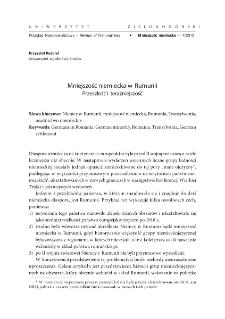Digital Library of Zielona Góra contains 65 391 digital objects
Object
Title: The german minority in Romania. The past and the present = Mniejszość niemiecka w Rumunii. Przeszłość i teraźniejszość
Contributor:
Kruk, Aleksandra - red. ; Pochyły, Piotr - red.
Group publication title:
Abstract:
The Germans of Romania are not a single group, this is only purely geographical notion. They are independent groups: Transylvanian Saxons, Satu Mare Swabians, Banat Swabians, Landler, Zipser, Bukovina Germans, Bessarabia Germans and Dobruja Germans. The largest and oldest group is Transylvanian Saxons. ; They entered this area in response to the invitation of Hungarian King Geza II. Swabians settlers in Banat colonized the wilderness let behind by the Turks during the reigns of Charles VI, Maria Theresia and Joseph II. In the 19th century German settlers come to Bessarabia from Russia. After the First World War Transylvania, the Bukovina, the Banat, Satu Mare and Bessarabia fell to Romania. ; They were a number more than 760 000 Germans in Romania in 1939, in 2011 only 37 000. The existence of German population in Romania is seriously endangered by emigration to Germany after 1989. In contemporary Romania the Germans are represented by the FDGR-party (the Democratic Forum of the Germans in Romania), which translates into only a single seat in the parliament. This minority plays a significant role in regional elections, one of example is the town Sibiu with Germans
Publisher:
Zielona Góra: Oficyna Wydawnicza Uniwersytetu Zielonogórskiego
Format:
Resource Identifier:
Pages:
Source:
Language:
License:
License CC BY-NC-ND 3.0:
Rights:
Biblioteka Uniwersytetu Zielonogórskiego
Object collections:
- Digital Library of Zielona Góra > Repository > Faculties > Faculty of Education, Psychology and Sociology
- Digital Library of Zielona Góra > Repository > Types of work > Articles
- Digital Library of Zielona Góra > Repository > Scientific journals and UZ publishing series > Review of Nationalities
Last modified:
Aug 1, 2023
In our library since:
Aug 1, 2023
Number of object content hits:
131
All available object's versions:
https://zbc.uz.zgora.pl/publication/82516
Show description in RDF format:
Show description in OAI-PMH format:
| Edition name | Date |
|---|---|
| The german minority in Romania. The past and the present = Mniejszość niemiecka w Rumunii. Przeszłość i teraźniejszość | Aug 1, 2023 |
Objects Similar
Kaźmierczak-Pec, Dorota Kruk, Aleksandra - red. Pochyły, Piotr - red.
Kruk, Aleksandra Kruk, Aleksandra - red. Pochyły, Piotr - red.
Homann, Johann Baptiste (1664-1724)
Cingelová, Gabriela Skobelski, Robert (1968- ) - red.
Jas-Koziarkiewicz, Marta Kruk, Aleksandra - red. Pochyły, Piotr - red.
Jarosz, Adam Kruk, Aleksandra - red. Pochyły, Piotr - red.
Pogorzała, Ewa Kruk, Aleksandra - red. Pochyły, Piotr - red.
Żarna, Krzysztof Kruk, Aleksandra - red. Pochyły, Piotr - red.

